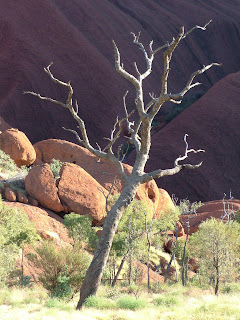Until the 1980's anyone could (and did) camp right at Uluru which of resulted in a lot of damage to what is now widely accepted as a sacred Aboriginal site. The Uluru-Kata Tjuta National Park is a World Heritage site listed for both its natural and cultural values. To try and limit the tourist damage a dedicated resort was constructed about 25km away with all accomodation and all visitors based there. It is an exceptionally well-organised resort that supposedly caters for all budgets. It cost me $72 to camp in an unpowered site for 2 nights. Even the tiny airport is custom-built. Everyone who goes through that airport does so because of Uluru. Kata Tjuta, an even bigger rock formation with arguably, even more cultural and visual significance, is there too... but of course, like most people, I didn't visit that. But I did get up at 5am to join an Uluru sunrise tour.
 Being lucky enough to grow up where I did, spectacular sunrises are not unfamiliar to me. However, the 360 degree uninterrupted view of the dawn breaking in the desert and awakening Uluru, while the Southern Cross melted into the blue, purple, pink and orange sky, was quite something else. Moments like that always create a dilemma for me. Do I just stand and absorb it, or do I try to capture it? Thankfully, unable to focus in very low light, my Fuji finepix made the decision for me and I just stood and stared, and let it wash over me.
Being lucky enough to grow up where I did, spectacular sunrises are not unfamiliar to me. However, the 360 degree uninterrupted view of the dawn breaking in the desert and awakening Uluru, while the Southern Cross melted into the blue, purple, pink and orange sky, was quite something else. Moments like that always create a dilemma for me. Do I just stand and absorb it, or do I try to capture it? Thankfully, unable to focus in very low light, my Fuji finepix made the decision for me and I just stood and stared, and let it wash over me.
The rock itself is magnificent. Uluru comes to life during sunrise and sunset. From a distance shadows play across the surface and the range of colours; brown, plum, red, orange, pink, beige, makes it seem like the monolith is actually breathing. Rising out of the flat desert it stands tall and beautiful with grace and dignity as little people-ants scurry around it.
 Following a 'bush breakfast' on the distant sand dune where we watched the sun rise in the bitter cold, we headed into the National Park to thaw out and to get a closer look at Uluru.
Following a 'bush breakfast' on the distant sand dune where we watched the sun rise in the bitter cold, we headed into the National Park to thaw out and to get a closer look at Uluru. It really is immense; over half a km high and 3km wide with huge slashes and holes across recognisable as snakes and other creatures making it easy to see how the Aboriginal stories evolved.
 In the afternoon I walked around the base of Uluru, almost 11km. Up close, it looks like a huge textured cloth, with ornate twirls and twists, is carefully pinned over the whole rock. Sections of it look like a gigantic honeycomb tiger loaf or a massive tree trunk, other parts like slabs of Swiss cheese.
In the afternoon I walked around the base of Uluru, almost 11km. Up close, it looks like a huge textured cloth, with ornate twirls and twists, is carefully pinned over the whole rock. Sections of it look like a gigantic honeycomb tiger loaf or a massive tree trunk, other parts like slabs of Swiss cheese. 
The walk was amazing. The colour, the texture, the beauty of the desert sand and the vibrant flora and fauna, like the five inch long Praying Mantra, the lizard and a moving train of about 20 'Hairy Mollys'. I knew when to get my camera ready based on the volume and pitch of the screams from the group of girlies in front of me. The flies were a bit of a trial and actively policed the place, making sure you didn't stop to take photos of the sections that were marked as sacred places for 'secret mens and secret womens business'.
Despite the site now being back in the ownership of the Aboriginal people living there (they now make up 75% of the management board of the resort and the National Park), there was a noticeable absence of Aboriginal people there. Even the staff in the Aboriginal cultural centre were predominantly non-Aboriginal. In fact, the whole time I was there I got the sense that I was being 'handled'. I also had a distinct sense of sadness of a lost people too. As the plane took-off and the white clouds obscured my view of the red centre the sense of sadness lifted. As I started thinking about other things, the sun shot an accusing ray through the window. It caught my boot where a red sandstone stain remained in silent protest at my easy forgetfulness.
 Uluru; spectacular, thought-provoking and worth seeing, and for a number of reasons this really was a 'once-in-a-lifetime' trip.
Uluru; spectacular, thought-provoking and worth seeing, and for a number of reasons this really was a 'once-in-a-lifetime' trip. 



























No comments:
Post a Comment